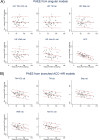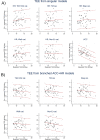Estimation of Free-Living Energy Expenditure by Heart Rate and Movement Sensing: A Doubly-Labelled Water Study
- PMID: 26349056
- PMCID: PMC4562631
- DOI: 10.1371/journal.pone.0137206
Estimation of Free-Living Energy Expenditure by Heart Rate and Movement Sensing: A Doubly-Labelled Water Study
Abstract
Background: Accurate assessment of energy expenditure (EE) is important for the study of energy balance and metabolic disorders. Combined heart rate (HR) and acceleration (ACC) sensing may increase precision of physical activity EE (PAEE) which is the most variable component of total EE (TEE).
Objective: To evaluate estimates of EE using ACC and HR data with or without individual calibration against doubly-labelled water (DLW) estimates of EE.
Design: 23 women and 23 men (22-55 yrs, 48-104 kg, 8-46%body fat) underwent 45-min resting EE (REE) measurement and completed a 20-min treadmill test, an 8-min step test, and a 3-min walk test for individual calibration. ACC and HR were monitored and TEE measured over 14 days using DLW. Diet-induced thermogenesis (DIT) was calculated from food-frequency questionnaire. PAEE (TEE ÷ REE ÷ DIT) and TEE were compared to estimates from ACC and HR using bias, root mean square error (RMSE), and correlation statistics.
Results: Mean(SD) measured PAEE and TEE were 66(25) kJ·day(-1)·kg(-1), and 12(2.6) MJ·day(-1), respectively. Estimated PAEE from ACC was 54(15) kJ·day(-1)·kg(-1) (p<0.001), with RMSE 24 kJ·day(-1)·kg(-1) and correlation r = 0.52. PAEE estimated from HR and ACC+HR with treadmill calibration were 67(42) and 69(25) kJ·day(-1)·kg(-1) (bias non-significant), with RMSE 34 and 20 kJ·day(-1)·kg(-1) and correlations r = 0.58 and r = 0.67, respectively. Similar results were obtained with step-calibrated and walk-calibrated models, whereas non-calibrated models were less precise (RMSE: 37 and 24 kJ·day(-1)·kg(-1), r = 0.40 and r = 0.55). TEE models also had high validity, with biases <5%, and correlations r = 0.71 (ACC), r = 0.66-0.76 (HR), and r = 0.76-0.83 (ACC+HR).
Conclusions: Both accelerometry and heart rate may be used to estimate EE in adult European men and women, with improved precision if combined and if heart rate is individually calibrated.
Conflict of interest statement
Figures


Similar articles
-
Accuracy of a combined heart rate and motion sensor for assessing energy expenditure in free-living adults during a double-blind crossover caffeine trial using doubly labeled water as the reference method.Eur J Clin Nutr. 2015 Jan;69(1):20-7. doi: 10.1038/ejcn.2014.51. Epub 2014 Apr 2. Eur J Clin Nutr. 2015. PMID: 24690589 Clinical Trial.
-
Accuracy and validity of a combined heart rate and motion sensor for the measurement of free-living physical activity energy expenditure in adults in Cameroon.Int J Epidemiol. 2011 Feb;40(1):112-20. doi: 10.1093/ije/dyq098. Epub 2010 Jun 6. Int J Epidemiol. 2011. PMID: 20529884
-
Validity of a combined heart rate and motion sensor for the measurement of free-living energy expenditure in very active individuals.J Sci Med Sport. 2014 Jul;17(4):387-93. doi: 10.1016/j.jsams.2013.09.006. Epub 2013 Sep 18. J Sci Med Sport. 2014. PMID: 24184093
-
Comparison of methods to assess energy expenditure and physical activity in people with spinal cord injury.J Spinal Cord Med. 2012 Jan;35(1):35-45. doi: 10.1179/2045772311Y.0000000046. J Spinal Cord Med. 2012. PMID: 22330189 Free PMC article.
-
Usefulness of motion sensors to estimate energy expenditure in children and adults: a narrative review of studies using DLW.Eur J Clin Nutr. 2017 Mar;71(3):331-339. doi: 10.1038/ejcn.2017.2. Epub 2017 Feb 1. Eur J Clin Nutr. 2017. PMID: 28145419 Review.
Cited by
-
Skipping Breakfast Before Exercise Creates a More Negative 24-hour Energy Balance: A Randomized Controlled Trial in Healthy Physically Active Young Men.J Nutr. 2019 Aug 1;149(8):1326-1334. doi: 10.1093/jn/nxz018. J Nutr. 2019. PMID: 31321428 Free PMC article. Clinical Trial.
-
Independent and joint associations of grip strength and adiposity with all-cause and cardiovascular disease mortality in 403,199 adults: the UK Biobank study.Am J Clin Nutr. 2017 Sep;106(3):773-782. doi: 10.3945/ajcn.117.156851. Epub 2017 Aug 9. Am J Clin Nutr. 2017. PMID: 28793990 Free PMC article.
-
Physical Activity, Sedentary Time, and Cardiovascular Disease Biomarkers at Age 60 to 64 Years.J Am Heart Assoc. 2018 Aug 21;7(16):e007459. doi: 10.1161/JAHA.117.007459. J Am Heart Assoc. 2018. PMID: 30369324 Free PMC article.
-
The association between self-reported physical activity and objective measures of physical activity in participants with newly diagnosed bipolar disorder, unaffected relatives, and healthy individuals.Nord J Psychiatry. 2021 Apr;75(3):186-193. doi: 10.1080/08039488.2020.1831063. Epub 2020 Oct 14. Nord J Psychiatry. 2021. PMID: 33779478 Free PMC article.
-
Objective Measures to Assess Active Commuting Physical Activity to School in Young People: A Systematic Review Protocol and Practical Considerations.Int J Environ Res Public Health. 2020 Aug 15;17(16):5936. doi: 10.3390/ijerph17165936. Int J Environ Res Public Health. 2020. PMID: 32824263 Free PMC article.
References
-
- Black AE, Prentice AM, Goldberg GR, Jebb SA, Bingham SA, Livingstone MB, et al. Measurements of total energy expenditure provide insights into the validity of dietary measurements of energy intake. J Am Diet Assoc 1993; 93: 572–579. - PubMed
-
- Klein PD, James WP, Wong WW, Irving CS, Murgatroyd PR, Cabrera M, et al. Calorimetric validation of the doubly-labelled water method for determination of energy expenditure in man. Hum Nutr Clin Nutr 1984; 38: 95–106. - PubMed
-
- Seale JL, Conway JM, Canary JJ. Seven-day validation of doubly labeled water method using indirect room calorimetry. J Appl Physiol 1993; 74: 402–409. - PubMed
-
- Wareham NJ, Rennie KL. The assessment of physical activity in individuals and populations: why try to be more precise about how physical activity is assessed? Int J Obes Relat Metab Disord 1998; 22 Suppl 2: S30–S38. - PubMed
-
- Avons P, Garthwaite P, Davies HL, Murgatroyd PR, James WP. Approaches to estimating physical activity in the community: calorimetric validation of actometers and heart rate monitoring. Eur J Clin Nutr 1988; 42: 185–196. - PubMed
Publication types
MeSH terms
Substances
Grants and funding
LinkOut - more resources
Full Text Sources
Other Literature Sources

